This was published 1 year ago
Our middle-distance runners haven’t won an Olympic medal for decades. But now…
In a field long dominated by Kenyans, Australia’s track athletes are gaining serious pace.
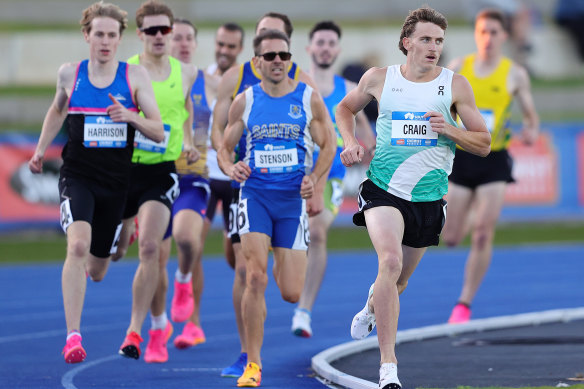
Peyton Craig in an 800 metres heat at the 2024 national championships. Part of a new, deep pool of local middle distance talent, the 19-year-old finished third in the final, just behind Olympic hero Peter Bol.Credit: Getty Images
It’s 8am on a Tuesday in April, and a testing laboratory inside the Victorian Institute of Sport fills with the staccato steps of a 19-year-old on a treadmill. Wearing a heart-rate monitor and breathing tube, he looks like a runaway hospital patient, except that he seems to be going rather fast.
He’s actually moving at about 15 kilometres per hour – a vicious pace for most runners, but to him almost effortless. Clinically so. Pausing for a pin-prick blood test of his lactate level – the lower your lactate, the greater your cardiovascular reserves – he’s clearly still in first gear.
“One point one,” murmurs supervising physiologist Avish Sharma. “That’s barely above resting.”
Honestly, the kid doesn’t even sweat until he hits 19 kilometres per hour, and he’s still cruising.
“Come on brother! Let’s go!” urges Sharma. “Push, push, push, push!”
This is a VO2 max test, an indicator of aerobic capacity – basically measuring the size of your athletic engine. And the motor of this athlete – Peyton Craig is his name, by the way – is revving with metronomic fury. The emerging 800 metres runner from the Sunshine Coast eventually reaches a top speed of 23 kilometres per hour before he’s finally gassed. And he’s pissed off, too, because he didn’t hit his personal best of 24.
Just to be clear, that’s two minutes and 30 seconds per kilometre. Under the imperial system, that’s on pace for a four-minute mile, once deemed such a preposterous goal that the race to get there first – won by Roger Bannister at Oxford 70 years ago – was the athletic equivalent of the moon landing.
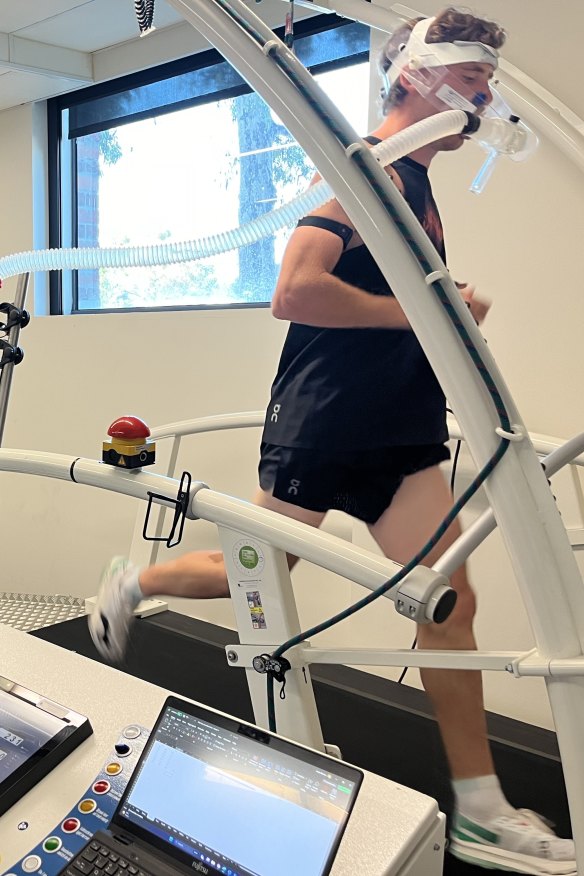
Peyton Craig undergoing a VO2 max test on the physiologists’ treadmill, part of Athletics Australia’s push to quantitatively tailor training.Credit: Konrad Marshall
Craig didn’t quite get there, but he was running with no crowd, competition or incentive on a random weekday morning in inner suburban Albert Park, and he did it after 10 kilometres of high-tempo running. He’s a neat example not only of how far middle-distance running has come in three-quarters of a century, but also how far Australians have come. Because I’m guessing you’ve never heard of Peyton Craig.
He finished third in the 800m at the national championships in April – a bare whisker behind Olympic hero Peter Bol – yet the young runner might not even make it to the Games in Paris. Why? Because the talent in our distance-running stocks (both men and women), especially over the middle-distance events (800 and 1500 metres), has never been deeper or more capable of doing damage on the world stage.
“I can’t speak on the era of athletics that came before me,” offers Craig, huffing down recovery breaths, “but this looks as good as it gets right now.” From the mouths of babes …
Speak to any expert and they’ll tell you Australia is experiencing a running renaissance, heralding the potential dawn of a golden era not seen since the 1950s and 1960s, the salad days that produced Olympic medallists such as John Landy (1956), Herb Elliott (1960), Ron Clarke (1964) and Ralph Doubell (1968). The statistical creep speaks for itself. In 2004, Australia took 10 distance runners to the Athens Olympics. In Beijing in 2008, that cohort leapt to 16. By 2016 in Rio, 24 were selected. Three years ago, there were 29 on the plane to Tokyo, five of whom reached a final – numbers that are only set to grow next month. “And it’s wonderful,” says Athletics Australia statistician Paul Jenes. “Maybe one day we’ll chase the swimmers with all their medals!”
But first, hard choices need to be made. We can take only three entrants to France for each athletics event, meaning some incredibly unlucky runners will meet the Olympic qualifying times, win hotly contested domestic races and place in prestigious international fields, yet miss out on the Games.
Catriona Bisset, for example, is the fastest Australian woman ever over 800 metres – the current national record-holder – but is not guaranteed a ticket.
“Twenty years ago, you used to get the qualifying time and you were in,” says Nic Bideau, perhaps Australia’s pre-eminent running coach. “It was like, great, they get a tracksuit, go to the Games, say they’re an Olympian – but most were shit. Now, if you get on the team, you’re not going to make up the numbers. You’re going to make the final.”

Catriona Bisset is the fastest Australian woman ever over 800 metres, but may not make the Paris team.Credit: Getty Images
Exactly how this happened involves everything from luck (a critical mass of genetic lottery winners) to geography (the gifted gathering in clusters), access to expertise (through a decentralised coaching model) and ever-expanding pathways (such as US university programs), as well as improved shoe technology, shifts in the economics of running, a growing online community of athletes and a new era of data-sharing. Not to mention inspiration from retired outliers like Craig Mottram.
Mottram, of course, challenged the established Kenyan dominance in middle-distance running two decades ago, beating reigning Kenyan world champion Benjamin Limo, for instance, to a silver medal at the 2006 Commonwealth Games in Melbourne. Now the man they used to call “The Big Mzungu” leads Peyton Craig and other jets as coach of the On Athletics Club Oceania.
“A lot of the best talent ended up in other sports because we didn’t have the mechanisms in place to capture and develop it. We do now.”
Craig Mottram
Running, he says, is still the broadest participation sport on earth, but more Australians choosing to compete is making a big difference. Craig, for example, was also a junior swimming champion and triathlete before settling on athletics a year ago, while Mottram’s star runner, Claudia Hollingsworth, 19 – who was just selected for the Paris Olympics in the 800m – chose running over a potential AFLW career.
“But that choice has gotta come from somewhere,” says Mottram, who runs a coaching business that helps scoop up such precocious athletes. “The ability has probably always been there, but a lot of the best talent ended up in other sports because we didn’t have the mechanisms in place to capture and develop it. We do now.”
That’s music to the ears of Andrew Faichney, the high-performance boss at Athletics Australia, who points back at people like Mottram – along with other coaches like Bideau (Stewart McSweyn and Georgia Griffith), Ned Brophy-Williams (Catriona Bisset and Linden Hall), Dick Telford (Cameron Myers and Jye Edwards) and Justin Rinaldi (Peter Bol), as leading this charge. “There’s this much wider group of coaches now, who know what it takes to get to the level,” Faichney says. “And there’s this challenge being laid down, from one group to another.”
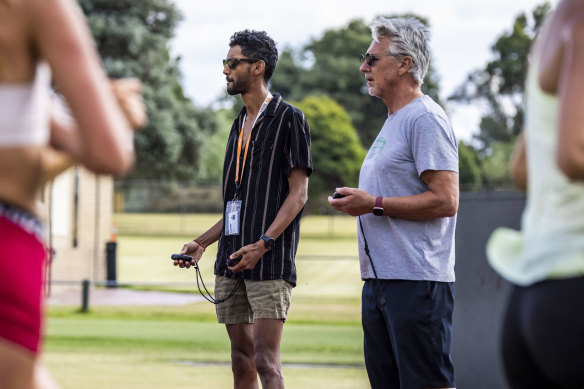
Physiologist Avish Sharma (left) and coach Nic Bideau, who says a Games medal “will happen”. Credit: Wayne Taylor
Athletics Australia is helping. A small example: four years ago, it had one physiologist employed for half a day each week. Now it has two full-timers in the role – Sharma and Brophy-Williams – bringing coaches the best possible evidence-based technology (like those VO2 max tests), which helps them to quantitatively tailor training. Faichney likes to say it’s become a “coach-facing” organisation, adding more workshops, conferences and formalised mentoring – and money for coaches to follow their runners overseas, instead of sending them into global competition alone. “I’m not saying this stuff never happened in the past, but it’s happening more systematically.”
The system for training athletes has also changed. After a poor showing at the 2012 London Olympics, athletics nationally became less focused on funnelling runners into the Australian Institute of Sport in Canberra, and more on supporting them in a diffuse way. Basically, if you’re talented, you can now train with whoever you want, and be based wherever you want.
That’s mostly been in Melbourne, the sport’s traditional stronghold. There’s history here –the eccentric Percy Cerutty famously coached Herb Elliott in the Portsea sand dunes – but also an infrastructure advantage. Elite athletes in Sydney can’t always train properly during school athletics carnival season, because there is a small number of synthetic “tartan” tracks compared with dozens in Melbourne. The statewide discrepancy is just as stark: NSW boasts around 20 tracks compared with 50-plus in Victoria. “It’s like that analogy around why there are so many champion swimmers from Brisbane – because there’s this concentration of pools in southern Queensland,” says Sharma. “Access to facilities makes a huge difference.”
Star 1500m runner Georgia Griffith grew up in Sydney before her family moved to Melbourne in year 9, when her running really took off. (Griffith made it to the Tokyo Olympics but tore her calf 10 days out; she now wants to go one better.) “There’s so many trail systems in Melbourne, and running squads everywhere – so many options,” the 27-year-old says. “There are really just not many tracks or trails in Sydney, and the weather for running is better here, too.”
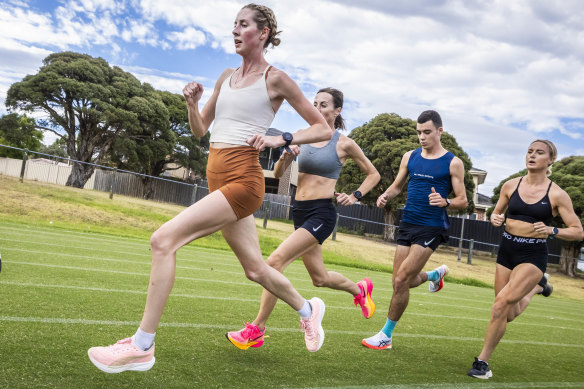
Star 1500 metres runner Georgia Griffith (brown shorts) says training facilities are better in Melbourne than Sydney.Credit: Wayne Taylor
Still, Victoria has nothing on America. The US college system is a big factor in our running resurgence, with about 150 young Australian athletes supported via sports programs at American universities. “As a sport, you grapple with that talent drain,” says Faichney, “because they go overseas and you lose them within our competition structure.” Yet the scholarship system also benefits Australia because it casts such a wide net, giving fringe runners a chance they might not otherwise get to develop. Competing frequently for US college teams, those runners learn tactical racing. Once they finish school and start training in long, uninterrupted blocks, they tend to make swift gains. “Linden Hall never made the world juniors’ team for Australia, but she got into a US college and developed,” says Sharma. “In her first year out of Florida State, she improved her 1500m time by around nine seconds, eventually set a national record and came sixth in the last Olympic final.”
“I’m always looking over my shoulder. These young guns coming through are killing it, and keeping everyone on their toes.”
National 1500m record-holder Jessica Hull
Stephen Haas, the Arizona-based agent for the likes of 1500m gun and new national record holder Jessica Hull, says leaving Newcastle to attend a top running school such as the University of Oregon placed Hull on an elite assembly line. “You have all the resources you could imagine in terms of psychologists, nutritionists, physiotherapists, biomechanists, the works,” Haas says. “They leave no stone unturned.”
Hull is now ranked eighth in the world, and is probably the best medal chance on the Australian track team. She credits her durability to her college program, where she loved being part of a team of 14 women. “There was a sense of purpose, not just for you,” Hull says. “You wanted to race well for something bigger than yourself.” The competitive dynamic of the current national team has forced the 27-year-old to train with more purpose than ever before. “I’m always looking over my shoulder. These young guns coming through are killing it, and keeping everyone on their toes. You can’t be at 95 per cent any more. There’s a new baseline.”
It’s a balmy autumn morning in Fitzroy Gardens, on the edge of the Melbourne CBD, and Tokyo games darling Peter Bol bounces on his toes with a handful of crack runners. They’re doing 200-metre hill sprints under the guidance of coach Justin Rinaldi. “Focus on your form!” Rinaldi yells. “Don’t get sloppy!” As they stride between rows of English elms, Rinaldi offers his take on the running upswing. “I think it’s just the internet,” he says, smiling. “We’ve got so much more access to other runners and what they’re doing.”
Back in the 1990s, when Rinaldi was running, the only way to assess his international rivals was to read the papers following big races, searching for scraps of coverage. Runners today have a wealth of information, thanks largely to the advent of Strava – basically Facebook for runners – where people list their distances, pace and elevation (and users give “kudos” instead of “likes”). Many professionals make their profiles public, seeing no need to keep opponents guessing.
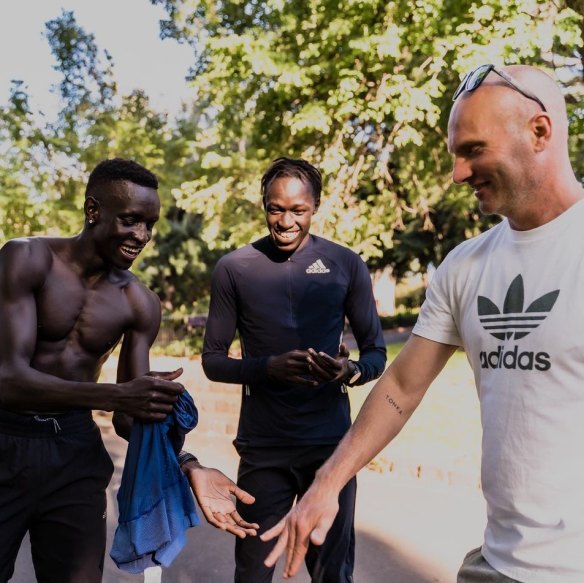
“Athletics is a pretty humble sport,” says Peter Bol (left) with fellow 800 metres star Joseph Deng and coach Justin Rinaldi.Credit: Instagram
Dick Telford, the Canberra-based coach of Tokyo Olympian Jye Edwards and running prodigy Cameron Myers – who, at 17, is already posting times that suggest greatness awaits – has been at this a while. Telford coached marathon runner Lisa Ondieki to an Olympic silver medal in 1988, and was a physiologist for the Australian swimming team before that, in an era when no one would have disclosed such data. “Now?” Telford asks. “If I wanted to know what the stars like Yared Nuguse [US] or Jakob Ingebrigtsen [Norway] are up to, my runners will be able to tell me – straight away – where they’re training, and the times they’re running. They actually begin to see them as colleagues. They seem reachable.”
The information helps coaches become more flexible and creative, too. Rinaldi recently got a great idea for his own fleet from an altitude workout posted by British 1500m runner Elliot Giles. “We’re just more willing to try new things,” he says, shrugging. “The older-school coaches had this mentality – ‘This is what we did in the 1970s, and what we’ll keep doing now’ – and it meant that we got to the 1990s and we hadn’t advanced at all.”
Social media plays a part, turning running into an appealing career. Many of Rinaldi’s guys learn how privileged they are to be globetrotting athletes by looking at the Instagram feeds of peers jogging through German forests or the New Mexico desert. “A 16-kilometre run is a lot of sightseeing – not many people would walk that far,” Rinaldi says. “It gets you up and enjoying yourself, seeing things tourists don’t see.”
Georgia Griffith, a Gen Z runner and digital native sponsored by Puma – and who last month set a new national record for the 3000 metres – says shoe companies are also rolling out showier online campaigns. “Some of the brands have put a lot of money in it, getting photographers and videographers to capture their training camps. It’s really slick,” Griffith says. “If you treat it as a good thing, you can gain a little inspiration and get yourself into the right mindset.”
Bol embraces it all, even hosting his own YouTube channel – a platform that led him to connect with British 1500m star Jake Wightman – first just messaging, then doing actual training sessions together. “It’s pretty cool how running is so collaborative and inclusive,” Bol says. “You can’t go and have a kick with your AFL team. You can’t jump in a car with your favourite F1 driver. But you can come to Collingwood on Saturday and run with me. Athletics is a pretty humble sport.”
If that sounds a touch too convivial to produce medals, those who would know say the hardware is on the way. Not necessarily in Paris, but perhaps at the Olympics after that. Nic Bideau casts his eye over a workout in suburban Glen Waverley, east of Melbourne, where more than a few dozen runners breeze around the spongy grass track. He gives me a pro tip for spotting the champions among them: “They’re the ones that look like gazelles.”
Sinead Diver is here, the Australian record holder and national champion in the marathon, as is her male counterpart, Brett Robinson. Griffith is running alongside one of her biggest competitors, Sarah Billings, and they’re not far from generational talent Stewart McSweyn.
“Let’s be real. We still haven’t won a middle-distance medal at the Olympics since Ralph Doubell in 1968, but we’re getting closer,” says Bideau with characteristic frankness. “It’ll happen.” Take the men’s and women’s 1500m in Tokyo – Australia had two runners in each final. Astonishingly, almost one-sixth of the field was Aussie. “Maybe this year we’ll get three in each final – a quarter of the field?” says Bideau. “That’s how you get medals.”
We’ve definitely improved since Tokyo. Prior to the last Olympics, the national record in the women’s 1500m was 4 minutes and 0.86 seconds. “Now, that time will only get you sixth place in Australia,” says Sharma. “You’ve essentially got to run past what the Australian record was only a few years ago, just to get on the team.”
It’s changing the way the Australian running calendar unfolds, too. Guns who used to be able to skip the domestic season can no longer ignore local races. A runner like McSweyn, for instance, spent previous Olympic years focusing solely on building to the Games. Now he has to look out for Olli Hoare, Adam Spencer, Jye Edwards, Jack Anstey and Cameron Myers.
They all need to prove they can race, too, because you don’t just hand in a time to win gold – you’ve got to beat people to the line, especially in the 1500m or so-called “metric mile”, a tactical race that produces occasionally flukey results. In the 2016 final in Rio, for instance, American runner Matt Centrowitz won gold in a sluggish three minutes and 50 seconds – the slowest run final since 1932 – courtesy of a blistering last-gasp kick. But that won’t happen again. “People said, ‘Nah, f--- that, we’re gonna make it a proper test of fitness,’ ” says Bideau. “You’re not going to get a slow race any more.”
That’s partly due to “the Ingebrigtsen effect”, named for Jakob Ingebrigtsen, the Norwegian superstar who won gold in Tokyo and is the subject (with brothers Kervik and Filip) of an upcoming Amazon series. The cocksure champion cultivates trash-talking rivalries, is adorned in patchwork tattoos, and has the simply stated goal of becoming “the best runner that ever existed”.
“The King” has thrown down the gauntlet, while McSweyn – our own “King of King Island” – enjoys the reminder that the best don’t rest. “It forces you to be a bit more full-on and committed,” he says. “Even in the off-season, the top guys aren’t skipping months of training. There’s this pressure to keep coming harder every year if you want to be anywhere near the mix.”
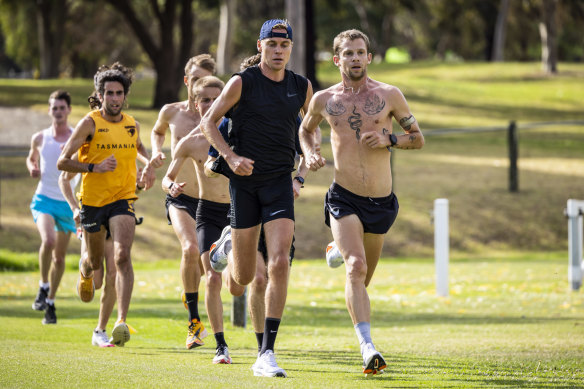
Tokyo 1500 metres finalist Stewart McSweyn (front, left) training with national marathon champion Brett Robinson (right).Credit: Wayne Taylor
They know precisely where they sit in the pecking order, too. Athletics Australia’s Paul Jenes says the international ranking system has become more sophisticated and transparent. Athletes can look it up straight after a meet and see where they sit. “That gives them this great incentive to get into better competitions against their immediate opponents and follow their own progress,” Jenes says. “It empowers the athlete.”
The Olympic selection process, however, remains complicated and opaque. Only a few middle-distance runners have been selected so far – Bol, Hull, Hollingsworth and Abbey Caldwell (who, like fellow Melburnian Hollingsworth, will make her Olympic debut in the 800 metres) – while the rest are still racing, hoping to prove themselves before the qualification period ends on June 30. The remaining runners will be chosen in early July by a selection committee with an unenviable task. “I’ve been a selector before – but not now, thank god!” jokes former marathon star and Athletics Australia director Steve Moneghetti. “Our problem back then was getting people into the team. Now it’s who you leave out.”
That was made more than clear in late May, during an ugly selection dispute after three female marathon runners – Sinead Diver, Genevieve Gregson and Jessica Stenson – were chosen for Paris, while Lisa Weightman was left out, despite posting the third-fastest time during the qualification period (Stenson was fifth-fastest). Weightman’s manager, Robert Joske, later told Nine’s Wide World of Sports that “the principles of the selection process are totally devoid of any ethics”. Yet there were factors in Stenson’s favour, including that her time was posted on a notoriously hilly course, only six months after giving birth to her second child (indicating room for improvement), not to mention her 2022 Commonwealth Games gold medal.
Weightman was ultimately left with one avenue to prompt a backflip – appealing to the Court of Arbitration for Sport. The potential $50,000 legal bill, however, was enough to persuade her to give up the dream of becoming the first Australian track and field athlete to compete at five Olympics.
Although not before her husband, Lachlan McArthur, was spurred to direct a post on X at Stenson, requesting she take down a photo of the two runners together, from happier times. The request was met, and McArthur responded: “We have a heartbroken family here.”
There are so many variables for selectors to consider. In the wake of the Weightman saga, Athletics Australia released a statement, attributed to its president Jane Flemming, which noted how selection is based on a blend of “metrics and discretion”. It’s not just the fastest times but when those times were posted. It’s not just podium finishes but who those finishes were against. Do you have a competitive record overseas – or only down at your local track? And will you have any strength left in reserve after a series of heats and semis, or are you a one-and-done runner? “Some people sneak into the final and do terribly, because they’ve already run their race,” Moneghetti says. “It’s not always straightforward.”
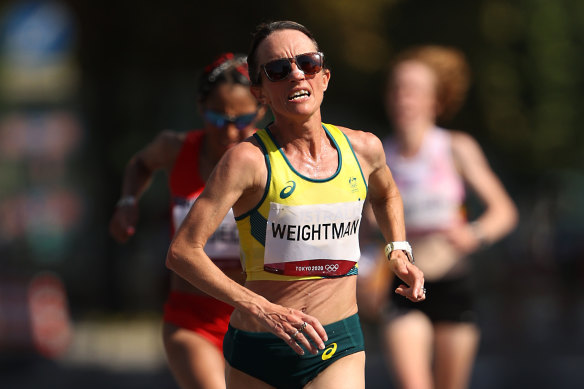
Lisa Weightman failed in her appeal to claim a spot on Australia’s Olympic marathon team for Paris 2024.Credit: Getty Images
Scheduling plays a part, too. Some runners excel over multiple distances, but if the heat of the 1500 is the same day as the 5000m final, they can’t run both. A choice needs to be made, so the selectors talk to coaches and athletes. Nothing is done in isolation. “Sometimes athletes get a bit carried away with ‘They don’t like me’ or ‘How come he got in?‘, but it’s not a raffle or a lottery,” Moneghetti says. “I always had this belief that you run to the best of your ability, and selection is something out of your control.”
That moment of brutal heartbreak is coming for a number of this year’s hopefuls. “It’s sad that people will miss out, but it’s also great because we’re so competitive on the world stage,” says Bol, who thinks of his friends from Kenya – runners who don’t even know the Olympic qualifying time, because it’s irrelevant. “Kenya probably has 16 guys who run that fast. Being in the top three is all that matters to them, and that’s the way it should be.”
On a related note, middle-distance running doesn’t involve quite as many Kenyans as it once did. Mottram was one of the first to pierce their unbeatable mystique, but more white athletes are competing at the highest level than ever, in part because black runners are simply competing elsewhere. “The money is all on the roads these days,” explains James Templeton, the agent representing Bol and Myers. “A talented young Kenyan guy who could have been a star in the 1500m is now after the cash you can get in these massive international marathons, where there are 50,000 runners, blanket coverage and sponsors putting up millions. It’s not just prize money but bonuses and appearance fees. It dwarfs all other running money.”
“There would be 50 Aussie runners or more sponsored by a shoe company right now … It used to be that the three best runners in Australia had a shoe deal.”
Coach Nic Bideau
Michel Boeting, the Dutch agent who has represented the likes of Kenyan superman Eliud Kipchoge – the first person to break the two-hour barrier for the marathon – says this shift has been supercharged lately. In the 1990s there were myriad lucrative track meets, but as the World Athletics body began pushing for the best showcase fields possible, second-tier meets disappeared while marathons took off. “The winner of the Rome Marathon this year won €15,000 [about $24,000], which is more than any Diamond League win, and it’s a fourth-tier marathon at best,” Boeting says. “If you look in China alone, there’s maybe 100 marathons.”
In Kenya, he adds, there are two kinds of athletes: the 20 per cent with a specific athletic ambition, and the 80 per cent who just want to make a living. “If the latter can go twice a year to China for three months and make $20,000, they’ll do that,” Boeting says. “Are they going to be millionaires? No. But are they going to have a good life back home? Yes.”
Boeting has one other theory about why Kenyans aren’t dominating the track as they once did, and it’s related to the new “super shoes” flooding the world of athletics. These shoes utilise a stiff carbon-fibre plate and an exaggerated foam cushion to give runners better return on energy expended. They’ve seen running times plummet for athletes all over the world – but Boeting isn’t sure everyone benefits equally. “There’s new research being done on ‘responders’ and ‘non-responders’ – to do with your build and size,” Boeting says. “I and some of my colleagues think Kenyans, with the way they’re built, and running so efficiently already, don’t get as much advantage.”
Whatever the reason, as white runners take flight, shoe company cash is shifting away from Africa. Nike and Adidas once sponsored the vast majority of world-class runners. Now manufacturers like Puma, On, Asics and New Balance are also investing in talent, and they’re flocking to Europe, America and Australia. “There would be 50 Aussie runners or more sponsored by a shoe company right now,” says Bideau. “It used to be that the three best runners in Australia had a shoe deal, but everyone’s got a bloody contract these days.”
The middle-distance ascendancy is happening in tandem with gains in shorter and longer distances – promising results in the 200 and 400, 5000 and 10,000 metres. Throw in the rise of amateur run clubs, and flourishing mass-participation events – like the record 840,318 applications received for the 2025 London Marathon – and you have a global grassroots platform. People are paying more attention, too, as evidenced by the national championships in Adelaide, attended by about 30,000 people, more than double the year before.
Dick Telford saw it first hand at a recent Sydney track meet, where his nascent star Cam Myers beat British champion Jake Wightman, not long after posting the fastest ever 1500m time by an under-16 (breaking the international record once held by Ingebrigtsen). “If you’re at a track meet and you have a little bit of talent, you get spurred on by that stuff,” says Telford. “To see the way the kids flocked up to Cam for autographs and selfies, it’s gotta rub off, doesn’t it?”
For Moneghetti, the equation is simple. There’s no great difference in talent around the world, nor in training, but there is a difference in the psychology of belief. He can see that belief now, every time our runners hit the starting line. “There’s been this perception for too long that Australians can’t be any good at athletics,” Moneghetti says. “But they’re doing something superhuman now. They’re saying ‘Yes we can,’ and they’re showing it with their legs.”
To read more from Good Weekend magazine, visit our page at The Sydney Morning Herald, The Age and Brisbane Times.